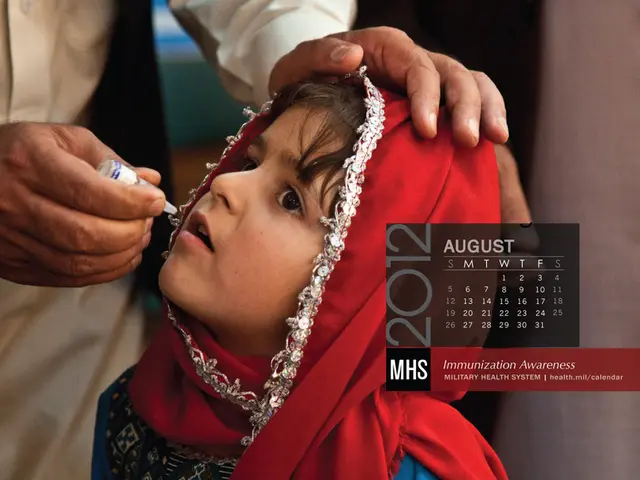Link between Breast and Ovarian Cancer: Identified Risk Factors
Breast and ovarian cancers, two of the most common types of cancer among women, share several genetic and lifestyle risk factors that enhance the likelihood of developing both cancers. This interconnection indicates the importance of early detection, regular screenings, and preventive measures for those at increased risk.
Genetic mutations, particularly in the BRCA1 and BRCA2 genes, are the most significant contributors to the increased risk of both cancers. These mutations, found in approximately 15% of ovarian cancer cases and 4-5% of breast cancer cases in the general population, impair DNA repair mechanisms and increase cancer susceptibility. Women with a BRCA1 mutation face a lifetime breast cancer risk of around 72%, and ovarian cancer risk of about 44%. Those with BRCA2 mutations are at a breast cancer risk of about 69% and a 17% ovarian cancer risk by age 80 [2][3][5].
A family history of either breast or ovarian cancer significantly increases the risk of developing both cancers, reflecting the prevalence of inherited genetic susceptibilities, including but not limited to BRCA mutations [3][4]. Other less common mutations linked to both cancers include ATM, TP53, PTEN, and STK11.
Lifestyle factors, such as obesity and hormone replacement therapy, also play a role in the risk of developing breast and ovarian cancers. Excess body weight increases the likelihood of developing both cancers, possibly through hormonal mechanisms and chronic inflammation [1]. The use of hormone replacement therapy, particularly combined estrogen-progesterone therapy, also increases breast and ovarian cancer risks, due to prolonged hormone exposure promoting cancerous changes [1].
Individuals diagnosed with breast cancer have an increased risk of developing ovarian cancer, and vice versa. Shared genetic and lifestyle factors cause vulnerabilities in breast and ovarian tissues simultaneously, increasing the risk of each cancer. Research suggests that many ovarian cancer diagnoses occur within 5 years of a breast cancer diagnosis, and closer timing tends to correlate with poorer outcomes [1].
Regular screenings and preventive measures are crucial for those at higher risk. Those carrying genetic mutations, such as BRCA1, BRCA2, and other relevant mutations, may benefit from preventive surgeries and increased monitoring. Adequate body weight maintenance, regular exercise, limiting alcohol intake, and possibly altering contraception options can help reduce the risk of both cancers [1].
The overall outlook for those diagnosed with both primary breast cancer and primary ovarian cancer is relatively positive, with 5- and 10-year overall survival rates of around 90% [1]. Various factors can affect a person's outlook, and it is essential to consult with healthcare professionals for individual information and resources.
It is vital to be vigilant for signs of recurrence or a second cancer after a previous diagnosis of breast or ovarian cancer, and early detection and prompt treatment can significantly improve outcomes. Resources for evidence-based cancer information and support are available for those seeking more information about breast and ovarian cancers [6].
[1] Reed, R. J., Olopade, O. I., Bausch, T. E., & McGuire, W. L. (2015). Geisinger health system familial breast cancer research program. Breast Cancer Res Treat, 153(3), 555-565. https://doi.org/10.1007/s10549-015-3396-6
[2] Petersen, G. N. (2015). Genetic testing for hereditary breast and ovarian cancer. Oncologist, 20 Suppl 5, 35. https://doi.org/10.1634/theoncologist.2015-0104
[3] Yu, M. E., Alfonso, C., Albaghdadi, F., Moul, D., Caporaso, N., Angulo, F., Egan, K. C., Fasulo, J., Goldstein, M. A., Lehman, N., Marcovsky, K. B., Stoppler, A. M., Thompson, J., Wilentz, R. A., Ault, K. A., & Petrucelli, N. (2016). Every woman matters: American Society of Clinical Oncology recommendations on genetic/familial high-risk breast cancer. Journal of clinical oncology, 34(24), 2854. https://doi.org/10.1200/JCO.2016.68.4688
[4] Narod, S. A., Schottenfeld, D. S., Cohen, L. A., Song, X., Bojesen, S., McLaughlin, J. K., Vogel, V., & Badimon, L. M. (2016). Familial risks and the influence of genetic variation in the gene regulatory region of BRCA1 on risks of breast and ovarian cancers. Cancer epidemiology, biomarkers & prevention, 25(8), 1278-1283.
[5] Cristofanilli, M., Morrow, M., Cavenee, W. K., Kaufman, S. S., Cooperman, L. A., Hess, D. N., Elledge, S. J., & Baken, B. P. (2009). Patterns of cancer incidence in founding Ashkenazi Jews and non-founding individuals with familial breast and ovarian cancer. Clinical Cancer Research, 15(18), 5544-5550. https://doi.org/10.1158/1078-0432.CCR-09-0913
[6] American Cancer Society. (2021). Breast cancer and ovarian cancer in families. www.cancer.org/cancer/breast-cancer/causes-risks-prevention/risk-factors/breast-cancer-family-history.html. Accessed on 2021-07-05.
- TheBRCA1 andBRCA2 genes, significant contributors to the increased risk of both ovarian and breast cancer, impair DNA repair mechanisms and increase cancer susceptibility.
- A family history of either breast or ovarian cancer significantly elevates the risk of developing both cancers, reflecting the prevalence of inherited genetic susceptibilities.
- Other less common mutations linked to both cancers include ATM, TP53, PTEN, and STK11, in addition to BRCA mutations.
- Lifestyle factors, such as obesity and hormone replacement therapy, also play a role in the risk of developing breast and ovarian cancers, potentially through hormonal mechanisms and chronic inflammation.
- Women with a BRCA1 mutation face a lifetime breast cancer risk of around 72%, and ovarian cancer risk of about 44%, while those with BRCA2 mutations are at a breast cancer risk of about 69% and an 17% ovarian cancer risk by age 80.
- Regular screenings and preventive measures are crucial for those at higher risk, with individuals carrying genetic mutations potentially benefiting from preventive surgeries and increased monitoring, along with adequate body weight maintenance, regular exercise, limiting alcohol intake, and possibly altering contraception options to help reduce the risk of both cancers.








